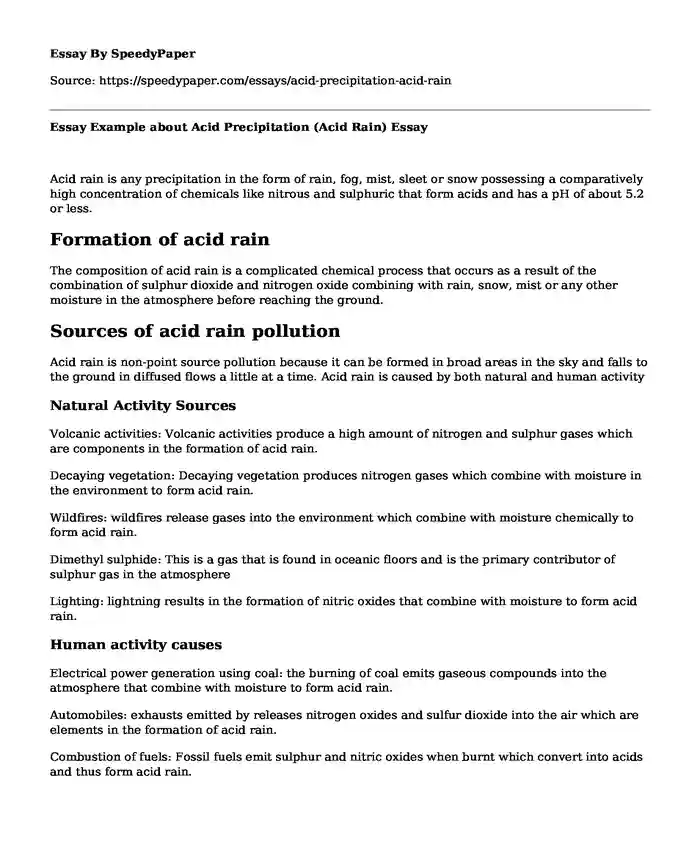
| Type of paper: | Research paper |
| Categories: | Air pollution |
| Pages: | 3 |
| Wordcount: | 732 words |
Acid rain is any precipitation in the form of rain, fog, mist, sleet or snow possessing a comparatively high concentration of chemicals like nitrous and sulphuric that form acids and has a pH of about 5.2 or less.
Formation of acid rain
The composition of acid rain is a complicated chemical process that occurs as a result of the combination of sulphur dioxide and nitrogen oxide combining with rain, snow, mist or any other moisture in the atmosphere before reaching the ground.
Sources of acid rain pollution
Acid rain is non-point source pollution because it can be formed in broad areas in the sky and falls to the ground in diffused flows a little at a time. Acid rain is caused by both natural and human activity
Natural Activity Sources
Volcanic activities: Volcanic activities produce a high amount of nitrogen and sulphur gases which are components in the formation of acid rain.
Decaying vegetation: Decaying vegetation produces nitrogen gases which combine with moisture in the environment to form acid rain.
Wildfires: wildfires release gases into the environment which combine with moisture chemically to form acid rain.
Dimethyl sulphide: This is a gas that is found in oceanic floors and is the primary contributor of sulphur gas in the atmosphere
Lighting: lightning results in the formation of nitric oxides that combine with moisture to form acid rain.
Human activity causes
Electrical power generation using coal: the burning of coal emits gaseous compounds into the atmosphere that combine with moisture to form acid rain.
Automobiles: exhausts emitted by releases nitrogen oxides and sulfur dioxide into the air which are elements in the formation of acid rain.
Combustion of fuels: Fossil fuels emit sulphur and nitric oxides when burnt which convert into acids and thus form acid rain.
Impact and Mitigation of Acid Rain
Impact on aquatic environment: acid rain finds its way into water bodies through rain or runs off waters and results in lowering the pH of water bodies resulting in the death of aquatic animals and elimination of some aquatic plant species.
Impact on vegetation: acid rain damages leaves and barks of plants are making them vulnerable to extreme weather and insects and thus leading to their stunted growth.
Impact on soil: acid rain leads to the death of soil microbes that cannot adapt to the low ph leading to a disruption in the biological and chemical processes that they perform in the soil beside leaching away vital minerals present in the soil.
Impact on architectural structures and buildings: acid rain corrodes buildings made of limestone, metal structures and even paint leading to economic and structural damages.
Impact on human health: gaseous particles in the air in the form of nitrogen and sulphur oxides causes lung and heart problems like bronchitis and asthma upon inhalation.
Ocean acidification: ocean acidification prevents the formation of the exoskeleton by certain ocean species leading to the extinction of some ocean species (Connell et al., 2013).
Mitigation of Acid Rain
Desulfurization: use of flue gas desulfurization in coal plants to reduce the amount of sulphur oxide present in the flue gases.
Automobile emission control: this results in the reduction of nitrogen oxides emissions from motor vehicles
Alternative energy sources: use of clean energy sources like hydropower and solar energy.
International agreements: international agreements like the Helsinki Protocol on the Reduction of Sulphur in 1985 under the Convention on Long-Range Transboundary Air Pollution aim at the control of gaseous pollutants in the environment( Ringquist & Kostadinova, 2005). Canada and the US signed the Air Quality Agreement in 1991 (Roelofs, 1993).
The Acid rain program: The program involves emissions trading; which consists in polluting facilities purchasing emissions allowance for each unit of a specific pollutant that it emits, after installation of pollution control equipment they can sell the emission allowance they no longer need (Ellerman, 2000).
Reference
Connell, S. D., Kroeker, K. J., Fabricius, K. E., Kline, D. I., & Russell, B. D. (2013). The other ocean acidification problem: CO2 as a resource among competitors for ecosystem dominance. Philosophical Transactions of the Royal Society B: Biological Sciences, 368(1627), 20120442.
Ellerman, A. D. (2000). Markets for clean air: The US acid rain program. Cambridge University Press.
Ringquist, E. J., & Kostadinova, T. (2005). Assessing the effectiveness of international environmental agreements: The case of the 1985 Helsinki Protocol. American Journal of Political Science, 49(1), 86-102.
Roelofs, J. L. (1993). United States-Canada Air Quality Agreement: A Framework for Addressing Transboundary Air Pollution Problems. Cornell Int'l LJ, 26, 421.
Cite this page
Essay Example about Acid Precipitation (Acid Rain). (2022, Apr 14). Retrieved from https://speedypaper.net/essays/acid-precipitation-acid-rain
Request Removal
If you are the original author of this essay and no longer wish to have it published on the SpeedyPaper website, please click below to request its removal:
- Essay Example about the Effects of Social Media on a Student's Education
- Free Essay Example on the Business Case Study
- Essay Sample: Science Can Build Sustainable World
- Poem Analysis Essay Example: They Say Plant Do Not Speak by Rosalia de Castro
- Distorted Image - Essay about Adolf Hitler, Free Example
- Paper Example on Domestic Violence by Eavan Boland
- Free Essay: The Use of Social Media in the Classroom
Popular categories




